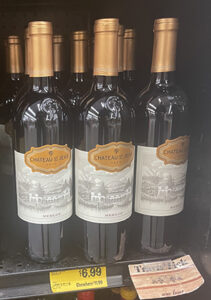Your West Coast Oenophile is starting to feel like the wine realm has returned to its pre-COVID demeanor, at least outside of the Napa-Sonoma axis. Having taken to the road on behalf of Sostevinobile last month, I trekked down to Paso Robles for Rhône Rangers, then stayed on to resume my favorite part of this occupation: visiting with the wineries. For this trip, I stuck with the Willow Creek District, what many consider the crown jewel among Paso’s sub-AVAs.
Among the places I stopped by was Denner, a premier winery that has long been on my radar. It did not disappoint: stunning architecture, incredible vistas—the hallmark of Paso’s westside wineries, and, of course, exceptional wines. Part of what Paso Robles such a dynamic wine region is its flexibility and experimentation. Unbound to the strictures of Bordeaux, as Napa mostly is, nor confined to other adherences, winemakers here feel free to c ross varietals from differing regions to create esoteric blends. Denner is one of the region’s foremost proponents of this unorthodox approach to œnology, amply demonstrated by the five new releases I sampled. The 2021 Theresa, while technically remaining within the strictures of the Rhône, married six white varietals: Roussanne, Grenache Blanc, Marsanne, Picpoul Blanc, Vermentino (Rolle), and Clairette Blanche, to produce a distinctive, if not proprietary blend that balanced just the right acidity to accompany any dish that called for white wine.
ross varietals from differing regions to create esoteric blends. Denner is one of the region’s foremost proponents of this unorthodox approach to œnology, amply demonstrated by the five new releases I sampled. The 2021 Theresa, while technically remaining within the strictures of the Rhône, married six white varietals: Roussanne, Grenache Blanc, Marsanne, Picpoul Blanc, Vermentino (Rolle), and Clairette Blanche, to produce a distinctive, if not proprietary blend that balanced just the right acidity to accompany any dish that called for white wine.
As billed, the 2021 Zinfandel might seem straightforward, yet with 7% Cabernet Sauvignon and 1% Petit Verdot as its blending components, this wine put a singular spin on its base varietals. Even more esoteric, the 2020 Ditch Digger augmented the traditional GMS (Grenache, Mourvèdre, Syrah) with both Carignane and Graciano to produce a most enticing mélange of this quintet. And the Carignane again played an atypical ancillary role in rounding out the otherwise orthodox Right Bank Bordelaise blend of the 2020 Gold Digger.
Perhaps even more esoteric, but easily as excellent, the 2020 Mother of Exiles focused on Cabernet Sauvignon, blended with nearly ⅓ Petit Verdot, then rounded out with Tannat as well as 1% Cabernet Franc. A truly remarkable wine at this early stage, with portents of a most superlative zenith over the next 3-7 years.
My procrastination in visiting Denner caused me to miss out on meeting with the original ownership, as sale of the winery marked Gallo’s entry into premium labels from the Central Coast. As always with such acquisitions, promises of non-interference and preservation of the brand have been made and so far kept. And, admittedly, I am somewhat placated by Gallo having reconfigured their operations and launched a luxury division to include their high-end brands like Denner and J. But such guarantees have been known to change.
A mere two years after purchasing Rosenblum Cellars for $105 million, Diageo shut down their Alameda facilities and rolled the label into their Napa operations ultimately eviscerating the prestigious label until it was acquired by Delicato and restored to its earlier luster under late winemaker Kent Rosenblum. Similarly, Gallo’s previous acquisition of Louis M. Martini revamped this Napa mainstay into a chimera that must have its founders spinning in their graves, while their redesign of alembic spirits pioneer Germain-Robin has been nothing short of tragic.
Still, nothing can quite compare to the dismantling of Château St. Jean. In its prime, St. Jean was a crown jewel of the California wine industry, so much so tha when the Merzoian family put it up for sale in the mid-1980s, it sold for what was considered nearly three times its valuation—much to my chagrin, my M&A client came in second in the bidding war—to Japan’s Suntory. Over the years, the winery changed hands numerous times, having lost its primary luster as the premier producer of vineyard-designate Chardonnays, only to recoup its glory with the 1996 Cinq Cépages, which won Wine Spectator’s Wine of the Year in 1999. The next year St.Jean was acquired by Treasury Wine Estates, which ultimately eroded the brand to the point that they eliminated its winemaker!
 Late in 2021, Foley Family Wines added St. Jean to its ever-expanding portfolio and promptly set about to revive the label. Part of the strategy, I suspect, is to dump all of its lower-end inventory from its Treasury reign and start anew. At least, so it seems, given the sheer volume of Château St. Wines being turned over at Grocery Outlet Bargain Markets.
Late in 2021, Foley Family Wines added St. Jean to its ever-expanding portfolio and promptly set about to revive the label. Part of the strategy, I suspect, is to dump all of its lower-end inventory from its Treasury reign and start anew. At least, so it seems, given the sheer volume of Château St. Wines being turned over at Grocery Outlet Bargain Markets.
Now, as previously stated in an earlier post, many savvy buyers, including myself, discovered this chain during the pandemic and realized there were true gems among the clutter of failed American Canyon bulk labels selling for $5.99. My policy when shopping here is to eschew any label I can’t recognized and only buy those I would gladly have purchased for full price elsewhere. And so I picked up a bottle of St. Jean’s 2019 Merlot, expecting it to be a sound choice.
My verdict? Quite possibly the worst wine I have ever tried outside of the undrinkable Two Buck Chuck served at cheap art gallery openings. And so my sober advice to Denner, harkening my 12 years of Latin studies, is “Caveat scriptor!”